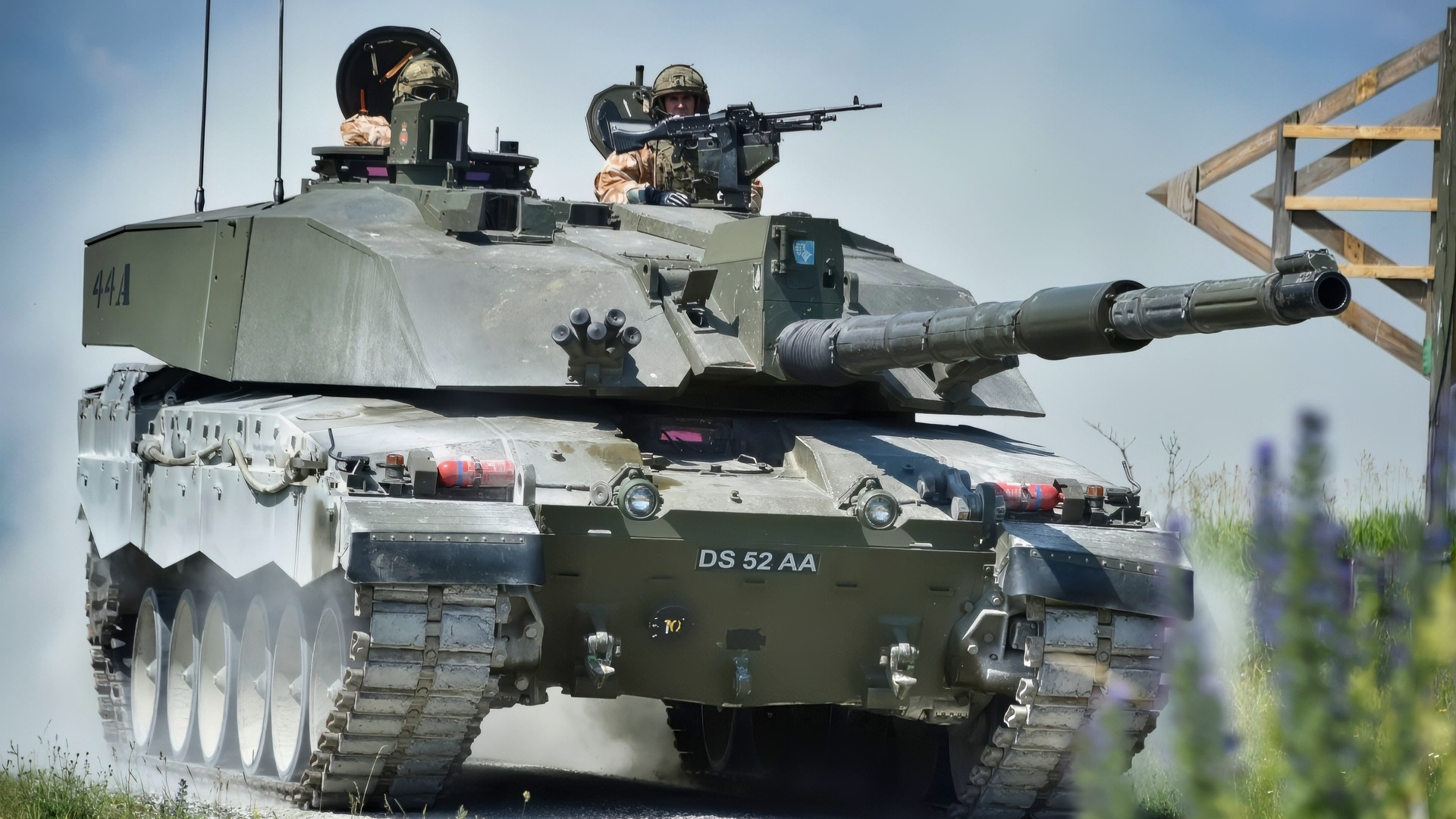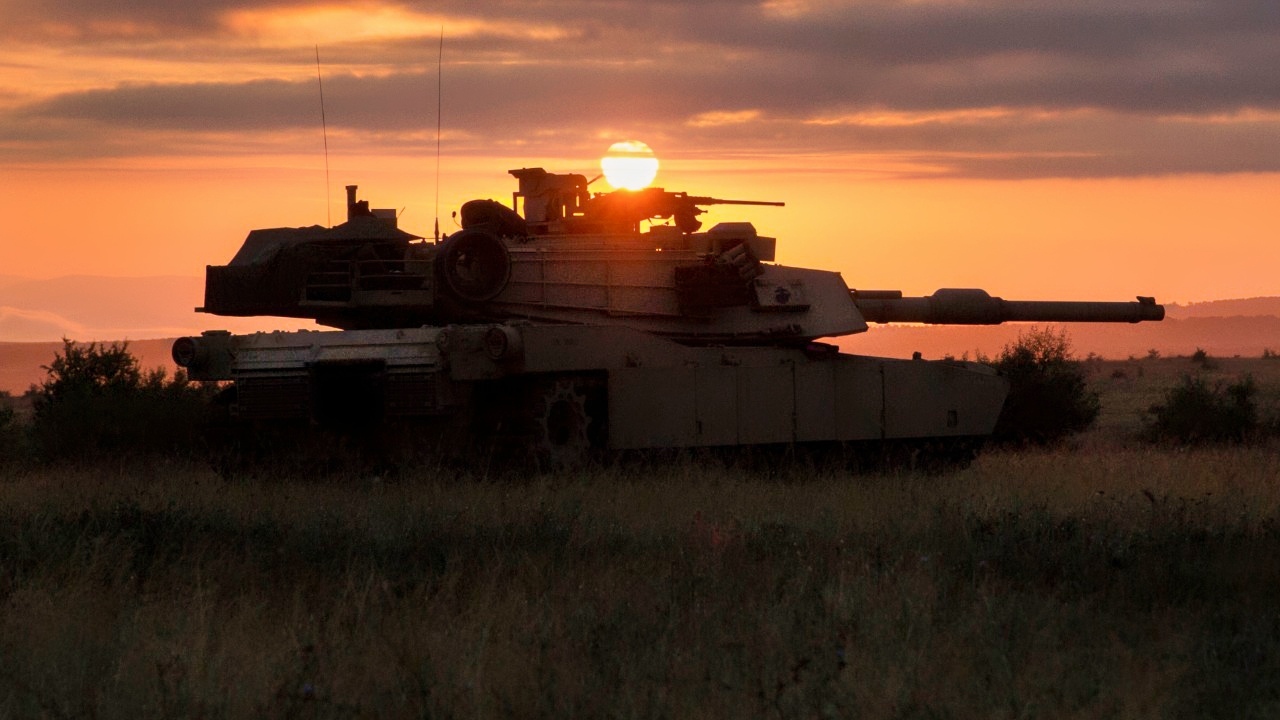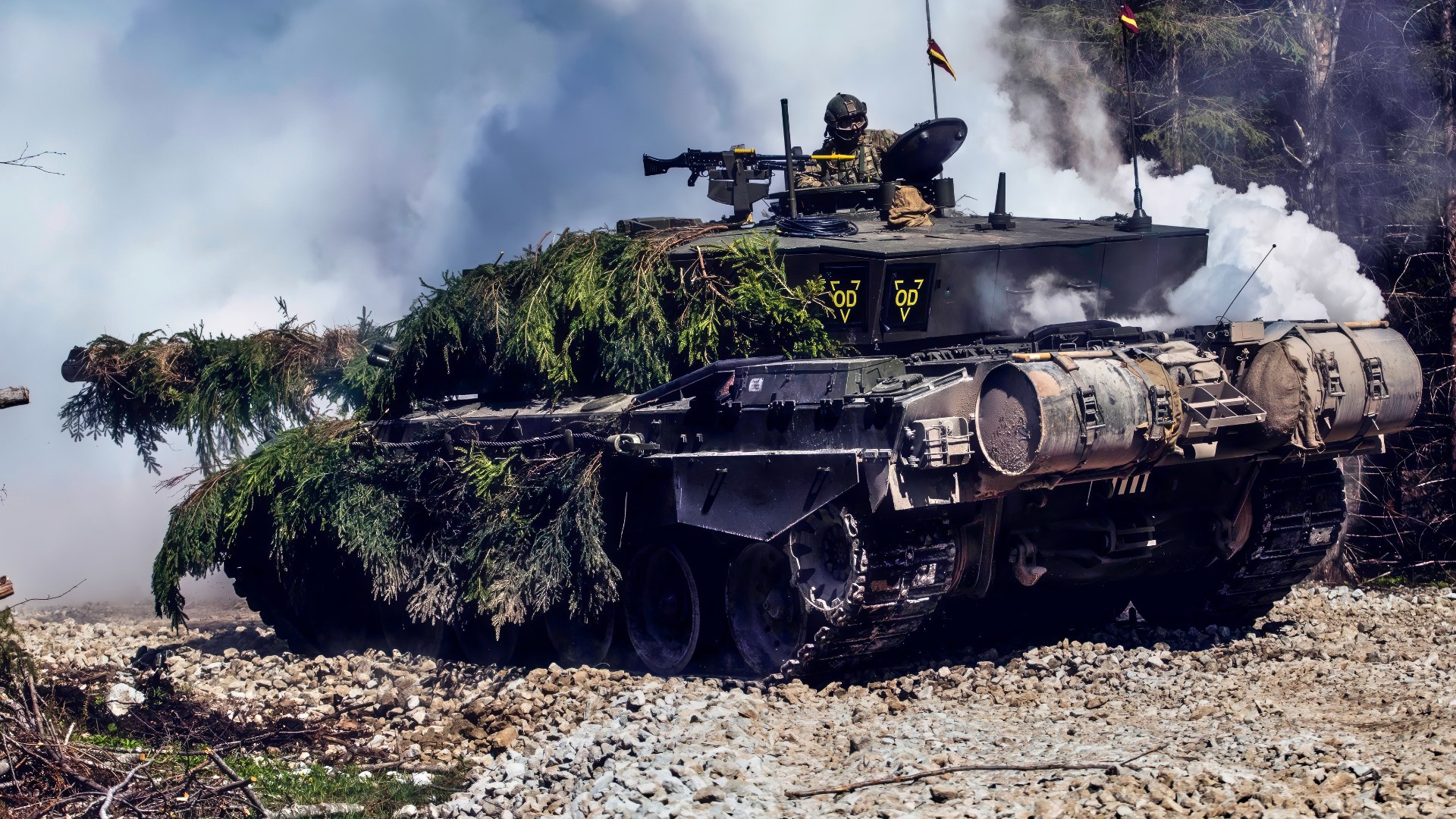Key Points and Summary – NATO faces a Russian war built on speed, software, and mass: swarming drones, relentless missiles, and fast-evolving electronic warfare.
-Allies are spending more and expanding shell and interceptor production, yet peacetime procurement rhythms still constrain scale and tempo.

Soldiers with the Hellenic Army fire a 120mm round from a Leopard A2 tank while scanning their sector during offensive operations for the Hellenic Tank Challenge 2021 at Petrochori Range, Triantafyllides Camp, Greece, Nov. 2, 2021. The Hellenic Tank Challenge 2021 is a competition that allows partnership building between Greece and the United States of America while enhancing unit readiness through competition. (U.S. Army photo by Staff Sgt. Jennifer Reynolds/RELEASED)

British soldiers with the Queen’s Royal Hussars move a Challenger II main battle tank down range during the Strong Europe Tank Challenge at the 7th Army Training Command’s Grafenwoehr Training Area, June 4, 2018. The U.S. Army Europe and the German Army co-host the third Strong Europe Tank Challenge, which is an annual training event designed to give participating nations a dynamic, productive and fun environment in which to foster military partnerships, form Soldier-level relationships, and share tactics, techniques and procedures. (U.S. Army photo by Gertrud Zach)
-To compete, NATO must lock in multi-year buys, prioritize cheap shooters and soft-kill effects, and treat repair networks and code updates as combat power.
-Industrial stamina across munitions, precision components, and software is decisive, as are forward repair hubs and data-fusion “drone walls.”
-Deterrence hinges on massing affordable effects quickly—shorter software cycles, fuller magazines, resilient logistics, and layered defense over exquisite one-offs.
NATO vs. Russia’s Drone War: Win With Mass, Not Marvels
Russia’s war on Ukraine is a war on speed and scale: cheap drones by the hundreds; cruise and ballistic missiles by the scores; electronic warfare (EW) whose logic can mutate on quarterly cycles. That is the fight NATO must be ready for—not an elegant, unhurried campaign of exquisite platforms, but a drone-and-missile war where software changes faster than doctrine, where ammunition depth decides what survives.
Keeping Pace With Wartime Needs and Technology Advances
Is the Alliance ready for that pace, that technology mix? Partly. Most allies are finally spending at serious levels, artillery output is climbing on both sides of the Atlantic, and adoption pipelines for counter-drone and electronic-warfare tools are shortening. Yet the core problem remains: Russia operates a wartime economy focused on volume, while NATO continues to buy like a peacetime bloc.
Unless the Alliance locks in multi-year buys, bends the cost-exchange curve toward cheaper shooters and soft-kill effects, and treats repair networks and code updates as combat power, it will struggle to keep up. The window to turn money into mass—and mass into tempo—is open, but not for long.
Start with what has improved. After years of exhortations, the two-percent benchmark for defense spending is now a real floor for most allies. Twenty-three of thirty-two met it in 2024, and several on the eastern flank are pushing well beyond. Money is not victory by itself, but it is the precondition for trained crews, deep magazines of munitions, and logistics that survive contact with reality. It also signals political resolve: when most allies pay the cover charge, deterrence appears to be a collective will rather than American charity.
Cash is translating into capacity. The United States has added load-assemble-pack lines for 155-millimeter shells and is aiming for roughly 100,000 rounds per month, despite interim targets having slipped and full-rate output remaining a challenge. Europe is backing an ammunition surge that aims to lift capacity to about two million shells per year by the end of 2025. Prime contractors are adding shifts, signing multi-year contracts, and planting new factories closer to the frontier. This is not press-release theater; it is welding torches and powder trucks rolling through the gates.
Components of War
But artillery is only part of the fight. Ukraine shows that missiles and drones set the pace and scale the pain. Independent tallies indicate that Russia’s long-range missile output will reach the hundreds per quarter by mid-2025. Ukrainian intelligence estimates that Moscow can now produce up to 2,700 Shahed attack drones a month. Whether exact numbers tick higher or lower, the logic is constant: saturate air defenses, force hard choices, and drain expensive interceptors faster than they can be replaced.

An M1 Abrams main battle tank provides security during the Combined Arms Company field exercise at Novo Selo Training Area, Bulgaria, Sept. 16, 2015. The CAC is a newly formed armor element supporting the Black Sea Rotational Force, which reassures our NATO allies and partners of our commitments and will enhance training exercises and operations with partners in the region. (U.S. Marine Corps photo by Cpl. Justin T. Updegraff/Released)
Western production of interceptors, sensors, and electronic-warfare kits is rising, but it remains tied to peacetime contracting rhythms and component bottlenecks that make months feel like years. If NATO had to ride out sustained salvos on Baltic or Polish infrastructure while protecting forward ground forces, ammunition depth could become the limiting factor in days, not months.
The Alliance’s advantage is quality. Allied jets, radars, and command networks still outperform Russia’s in a slugfest. That advantage only matters, though, if our systems continue to function when the airwaves are jammed and the sky is filled with drones.
On that score, NATO is moving to change how it buys and fields technology. Instead of flashy “innovation” demos, NATO is developing pipelines to draw promising civilian startups into military testing and shepherding practical tools—such as counter-drone defenses, backup navigation when GPS is spoofed, and autonomous intelligence/surveillance gear—into daily operations. A fast-track process, to be agreed upon in mid-2025, aims to narrow the gap between “it worked in a demo” and “it works with a brigade in the field.”
Eastern-flank governments are building layered “drone wall” concepts—detect first, intercept second—to keep their airspace from becoming a live-fire lab. The early focus is on sensing networks and data fusion rather than expensive shooters. That instinct is correct: sense more, fuse faster, shoot cheaper. But delivery will phase in over years, not months, and success will hinge on procurement rules that can buy software and sensors at the speed they evolve.
Industrial War Machine
Industrial stamina is the hinge. Think of three overlapping sectors: heavy industry for shells, propellants, and explosives; precision industry for seekers, guidance, and interceptors; and software industry for autonomy, electronic warfare, and rapid updates.
NATO needs all three—simultaneously, at scale. That requires rebuilding supply chains that atrophied after the Cold War; pulling semiconductor, optics, and battery makers into defense-priority lanes; and friend-shoring critical subcomponents that still seep through sanctions networks. It also means writing contracts that buy learning curves, not just boxes: multi-year commitments that allow firms to invest in machines and people, paired with modular upgrades so that software, payloads, and EW tactics can be updated at wartime speed. Otherwise, the Alliance will keep purchasing exquisite answers to yesterday’s problems while the other side ships “good enough” in bulk.
From Manufacturing to Logistics
Logistics needs the same no-nonsense approach. If Europe and North America can’t transport heavy equipment to the fight faster than Russia can wear it down, combat power will decline even as spending increases. Meeting that test is not only about ports, railcars, and bridges; it also includes repair—the unglamorous work of keeping radars, launchers, drones, and jammers operating under constant electronic and physical duress.
Ukraine has demonstrated that dispersed repair networks maintain a force in the fight when orderly supply chains break down. NATO should solidify that lesson with forward repair hubs, containerized power and communications, and deep stocks of critical components—circuit boards, tubes, and the rest—treated as munitions, not afterthoughts.
Keeping Pace in the Fight
Could the Alliance truly ramp up enough capacity to fight a drone-and-missile war with Russia?
Compared to early 2022, yes. Today’s NATO is better funded, less complacent, and relearning mass. The pace problem remains. Russia has built a wartime economy under command-style management—throughput mandates, redirected supply chains, and design tradeoffs in service of volume. NATO fights with liberal-democratic tools—rule-bound contracting, environmental constraints on energetic expansion, and a workforce that cannot be surged by decree.
Democracies should not try to become like Russia to beat Russia. They can, however, adjust their approach: lock in multi-year purchases across allies, consolidate demand to stabilize supplier investment, and shift software and EW development to six-month cycles instead of six-year cycles.
Lessons Learned in Advance of the Battle
One last lesson is obvious and often ignored: the cheapest shooter that can do the job usually wins. A loitering munition costing in the tens of thousands that disables a multimillion-dollar radar is a victory; a high-end interceptor swatting a bargain drone is not. Bend the cost-exchange curve. Field more guns with programmable airburst rounds. Expand soft-kill options—jamming, spoofing, dazzlers—against cheap drones. Buy attritable reconnaissance drones in volume—reserve premium interceptors for premium threats. Treat money like ammunition.
Deterrence this decade will not turn on a miracle weapon or another grave communiqué. It will turn on whether NATO can scale forces and munitions without compromising standards, whether it can adapt without becoming brittle, and whether it can spend more without wasting more. The Alliance is finally thumbing through the right playbook—deep stocks, distributed risk, layered denial, speed in industry and in code—but only matters if you run the plays.
Crank up the factories. Shorten the software loops. Wire the front for resilient sensing and repair. Do that, and the tempo that now appears to be a Russian advantage starts to look like a NATO trap. Failure and time become the deciding factors, as mass-produced by the side with hotter factories, shorter software loops, and repair crews already in motion.
About the Author: Dr. Andrew Latham
Andrew Latham is a Senior Washington Fellow with the Institute for Peace and Diplomacy, a non-resident fellow at Defense Priorities, and a professor of international relations and political theory at Macalester College in Saint Paul, MN. You can follow him on X: @aakatham. He writes a daily column for the National Security Journal.
More Military
The U.S. Navy’s Great Ford-Class Aircraft Carrier Reboot Has Arrived
The U.S. Navy’s Great Iowa-Class Battleship Reboot
Is the Ukraine War ‘Shapeshifting’ Into the Vietnam War?
China’s Great J-20 Mighty Dragon Stealth Fighter Reboot Has Arrived











Jim
October 3, 2025 at 2:26 pm
This is the article I expected for a long time (from a different source).
But I expected it from one of the T. V. Generals, “We have to go to a wartime economy… all our efforts have to be directed into our war fighting ability. Our efforts must be focused on mass production. That requires full military mobilization… our freedoms & the American Way require it.”
(And the presenter nods in quiet assent… no follow up questions.)
Now, I firmly believe in readiness & preparation, so the recommendations herein are valid.
But not for this war of choice we brought on ourselves with our hubris & arrogance thinking we could inflict a strategic defeat on Russia.
This war needs to be ended… period!
Trump was captured by the Keith Kellogg crowd:
“Mr. President (before inauguration), you can get a twofer: end the war for MAGA and satisfy the Washington Establishment; Kellogg’s demarcation line and ‘cease fire’ will incorporate all Ukraine in NATO, minus the 20% in Russian hands (which we can get later), Washington will take that as a “win” and so can you.”
Didn’t work out that way.
Alaska was Trump’s last-ditch Big Sell to get Putin & the Russians to buy into a demarcation line and cease fire (but designed to be permanent… “how dare you break the cease fire… Putin & the evil Russians want to take all of Europe” and so on…)
Didn’t work.
Now, Europe, the real paper tiger in all this, is running all around with their hair afire.
Stop it.
It will take several years to build our stocks up to prewar levels, so badly have our ordinance stocks been depleted by this disastrous and ultimately failed policy…. too much more of this depletion… and we’ll be the paper tiger… caught with our pants down.
No.
We can do all the things recommended herein, bur not on a crash course… trying to catch up like a dog chasing its tail (if we are to continue this failed policy) never quite catching its tail… until it gets worn out.
With some resignation, military readiness & preparation should be done expeditiously, but most important, not letting it take over our economy like the MIC wants to do.
I’ll tell you a secret: the MIC eyes our current military expenditure as a percentage of U. S. GNP and believes it could easily be kicked up a couple of points from where it presently is now.
Wars of choice are damaging to democracy, so said James Madison, Father of the Constitution, and the 4th President of the United States.
He’s right you know.
Stop the wars of choice.
Build our stocks and strategies for the 21st Century.
Peace through Strength… it still works, we should try it.